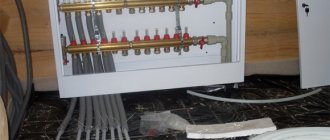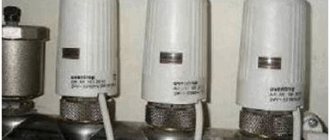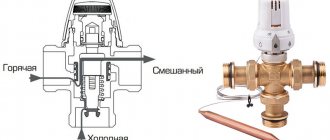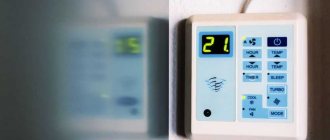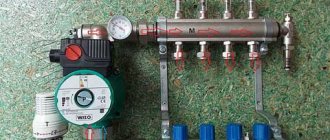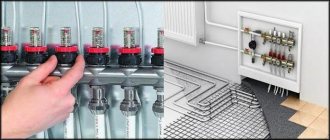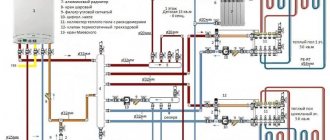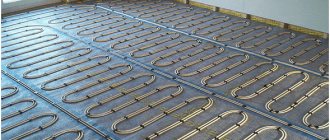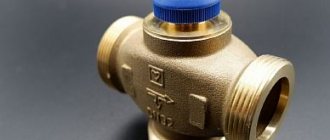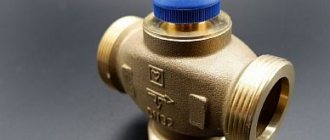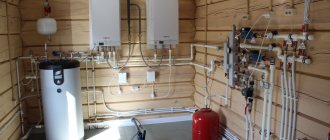In the past, very strict requirements were not put forward for heating systems - it was enough that the room was warm. In addition to reliability, a modern heating system must also provide the ability to adjust the temperature over a wide range. The servo drive is precisely recommended to make the heating as responsive as possible; it allows you to regulate the temperature in the room with an accuracy of a degree
Node Description
The servo drive for a warm water floor regulates the temperature of the supplied coolant. This occurs due to the fact that this unit controls the opening and closing of the manifold valves.
Installation diagram of servo drives for heated floors
The servo drive for a warm water floor consists of a spring mechanism and a small container with liquid. An electric current passes through the nichrome element. It is he who heats the liquid in the bellows, which, as a result of this effect, expands and acts on the rod.
It extends and presses on the thermal valve. This mechanism is called a thermal drive because it works by expanding the liquid inside under the influence of high temperature.
When voltage is applied, the valve closes only after 1-3 minutes. This time is necessary to warm up the liquid. If there is no voltage, the mechanism cools down, which takes a lot of time. As a result, the valve returns to its original position. This requires from 5 to 15 minutes.
Heating manifold servo drive
There is also a servo drive for a warm water floor collector without liquid inside. In such models, the movement of the rod occurs when the compensation element is heated. It is a plate or spring. During heating, the thermoelement expands and changes its position.
Rehau heated floors and servo drives
The manifold servo is also equipped with a retractable mechanism, which is located in the upper part of the housing. It is designed to determine the fit of the actuator in the thermal valve. A retractable mechanism indicates whether the device is turned on or not. The servo drive for a warm water floor is necessarily equipped with overheating protection. Its body houses a mechanism that allows you to automatically turn off the power.
Servo drive and its varieties
The servo drive regulates the flow of water into the system
. As mentioned above, the servo drive is an additional equipment that is installed on the distribution manifold for a warm water floor.
The device is used to regulate the flow of water entering the heating elements. This process is carried out by opening and closing control valves, which are located on the return comb of the manifold.
Mechanical servo drive
This device is the simplest version.
A mechanical servo drive is the simplest version of this device.
It has a simple design and reasonable cost.
The temperature is adjusted directly on the device itself by rotating a special wheel that decreases or increases the temperature.
There is no need to control the device itself; the main thing is to set the required value, and a servo drive of this type will control the temperature.
Mechanical devices are not combined with a temperature sensor.
Such a device is not coordinated with a temperature sensor and cannot automatically operate (turn on and off) when the temperature of the heated floor increases and decreases from a given setting.
The device requires constant monitoring of the temperature when leaving home and even before going to bed, but its service life is very long and the device does not require preventative settings or additional maintenance.
Electronic servo drive for manifold
The electronic device receives information from a temperature sensor.
The electronic version of the heated water floor servo drive is also a fairly simple device that is capable of automatically adjusting the supply of coolant to the heating circuit of the system.
Servo-drive commutator circuit
The device is in constant electronic coordination with the thermostat, which is the brain center. The thermostat or thermostat is coordinated with a temperature sensor, which is installed near the heating elements in the heated floor screed.
Accordingly, the temperature limits at which the servo drive will open and close the adjustable valve to supply hot water to the heating circuits are set on the thermostat. One of the options for connecting a thermostat to servos can be seen in the table diagram.
An electronic type device is capable of completely independently producing and controlling the supply of coolant to the heating system, but in order to purchase it, each owner will have to shell out a considerable amount of money.
It should be remembered that when choosing an electronic servo drive, it is necessary to take into account the characteristics of the room itself, or rather the power supply area. You should also pay attention to how often power outages occur.
If they happen often, then you should additionally install a UPS (individual power supply) or opt for a mechanical device for regulating the coolant supply. For more information about servos, watch this video:
Main manufacturers
Today, the leaders in the production of high-quality water heated floor systems with various characteristics include manufacturers of the following brands.
- Luxor.
- Valtec.
- Watts.
- Rehau.
- Neptune.
- Henco.
Luxor
Equipment for Luxor water heated floors in the Russian markets is represented by 4 types. The system based on two collector beams (return and supply combs) is brand CD 468 with a number of outputs from 3 to 12. Model CD 477 is equipped with flow meters. The CD 468 M model series has ball valves equipped with temperature sensors. A number of CD 473 M systems are distinguished by the presence of air vents and drain taps. Luxor systems are sensitive and require constant monitoring of the technical condition of the equipment.
Valtec
The company has completely switched to using cross-linked polyethylene pipes in its circuits. Unlike simple polyethylene, whose molecules are not interconnected, a cross-linked polymer has close molecular bonds, which gives the products high strength. The disadvantage is that the pipelines have difficulty maintaining the bends of the loop; they have to be secured with additional clamps.
Watts
The Watts company is distinguished by the fact that it supplies heating units to the heating equipment market fully equipped and ready for connection. This achieves the effect of quick installation. In its latest developments, the company presents a radio wave thermostat, which allows it to be installed anywhere in the room.
Rehau
Rehau company supplies high quality equipment, which is reliable, small in size and easy to install. The control unit is installed within a short time, which allows for quick connection of servos to the switch. Some disadvantage is the high cost of the equipment.
Neptune
The only Russian company supplying water heated floor systems with corrugated stainless steel pipes. They differ from polymer analogues in that they have almost ideal heat transfer and are not afraid of freezing and water hammer. The equipment delivery set includes all the necessary fittings, thermal insulation mats and a circulation pump.
More about the design
By design, servo drives can be divided into 2 groups of devices – electromechanical and electrothermal. In the first, mechanical gearing is used to set some part in motion. In electrothermal devices, instead, the property of a liquid (gas, solid substance) to change its quantity when heated is used, and they are used in heating systems.
When choosing a specific model, you need to know the designations used; you will see options such as:
- normally open/closed;
- voltage 230 or 24 V.
Everything is clear with voltage - 230 V means powering the device from the mains, and 24 V means using batteries. But open/closed are directly related to the operating mode and scope of application of the device.
- the normally closed type, when the circuit is closed, releases water through a section of the pipe, just this type is used in space heating;
- normally open - on the contrary, when the circuit is closed, it blocks the movement of the substance through the pipe; such devices are used mostly in air conditioners and refrigeration equipment.
Device and principle of operation
The main element of this device can be called a sealed chamber with a corrugated wall. This chamber may contain a gas, liquid, or solid substance - when heated, it will change the dimensions of the bellows (sealed chamber) and regulate the flow of the substance through the pipe.
During operation, a thermostat located anywhere in the room signals to the servo drive that the temperature exceeds the optimal one. The circuit closes and current begins to flow through it.
Along with this, the bellows heats up and elongates. When extended, the bellows begins to put pressure on the valve stem, reducing the passage opening in the pipe.
The design is spring-loaded, so that after the chain opens again and the bellows cools, the spring will return the pusher to its original position, and the passage hole will increase in size.
Installation Features
When installing the servo drive independently, the instructions will look like this:
- First, a thermostat is installed in the room - it will record changes in air temperature;
- after this, a two- or three-way valve is installed (the highlights of each type of valve are discussed below);
- A servo drive is installed specifically on the valve and connected to the thermostat. The device is receiving power.
Note! In 4-wire servos, 1 contact is provided for possible connection of other devices.
If all the connection work has been completed correctly, the LED on the servo drive head should light up; based on its color, it is possible to draw conclusions about the position:
- light blue color indicates that the device is now de-energized, in other words, it will be in the open state;
- The green indicator informs that voltage is supplied to the device, in other words, the servo drive is closed.
Application of two- and three-way valves
The servo drive can be used with two-, three- and four-way valves. In heating systems, the first 2 types of valves are much more often used.
Two-way valves with a servo drive are, in most cases, installed in front of radiators. Such a device has only an inlet and an outlet, and changing the passage hole allows you to regulate the flow of coolant through the valve. Installation of the control device is done by hand.
Three-way ones provide significantly more chances. Installing a servo drive allows you not only to regulate the coolant flow through it, but also, if necessary, to isolate the heating circuits from each other.
Note! Separation of heating circuits is simply necessary when using simple radiator and low-temperature heating (warm floors).
During temperature control, the servo drive on the 3-way valve can, for example, organize the addition of water from the return line into the supply pipe. This gives a 100% guarantee that excessively warm coolant will not enter the heating device.
Scope of application
In a heating system, it can be installed in various places, for example, if it is necessary to regulate the flow of coolant into the heating device, it is installed on the supply pipeline. But the servo drive of the heater damper will allow you to regulate the flow of air into the boiler furnace, in other words, the heater power will be adjusted (read also the article 'Modern heating Terem - a high level of quality at an affordable price').
Adjusting the room temperature is much more often done using two methods:
- through thermostats - a good option if heating radiators are used. Under such conditions, regulators are installed in front of each battery and automatically regulate the flow of coolant into the radiator,
- via a servo drive - much more often used when it is necessary to regulate the temperature of heated floors.
Note! Servo drives can be installed on the heating manifold comb instead of simple thermal heads.
In the case of heated floors, it is especially important to keep the coolant no higher than a certain temperature. If, for example, you regulate the supply of coolant using simple thermostats, then when starting the system, a situation may arise when warm water is sent into the pipes. As a result, it will not be difficult to walk on the floor uncomfortably for some time, and some of the pipes may also fail.
Installing a servo drive with a 3-way valve upstream of the manifold will avoid this. In most cases, this is what I do, especially since the price for the device is minimal.
Review of popular models
Servo drives for water heated floors are produced by different manufacturers. Each model has its own characteristics.
VALTEC
VALTEC is a manufacturer of devices for water and heating supply for the home. A group of Russian and Italian specialists is working together to create products. VALTEC produces the following drives to regulate the operation of a floor-type heating system:
- TE3042.A. Belongs to the group of normally open. Designed to control valves of climate systems using commands that will be set by a thermostat, controller or manual switch. Device power – 2 W, conductor cross-section – 0.75 sq. mm. The connecting size is M30x1.5;
- TE3061.0. This is a normally closed electrothermal device. Designed for three-way valves. The operation of the device is possible due to the thermal expansion of the liquid - toluene. Drive power – 2 W, conductor cross-section – 0.22 sq. mm;
- TE3041A.0. The device works thanks to the presence of liquid in the body, which expands under the influence of temperature. Belongs to the group of normally open. Connection to the valve occurs through an adapter, which is included in the kit. Unit power – 1.8 W, conductor cross-section – 0.75 sq. mm.
Watts
Watts is the world's leading manufacturer of heating equipment of various formats. It is distinguished by high quality, affordable price and efficiency. Servo drives from Watts are models with an electromagnetic motor. Popular series:
- 22C. It is installed on the return pipeline valve and regulates the flow of coolant into the underfloor heating system. Power is 2.5 W. Depending on the model, the 22C series includes normally open and closed devices. Protection class – IP44;
- 22СХ. They belong to electrothermal devices to ensure the efficient operation of water heated floors. There are normally closed and open models. The level of power consumption in normal operation is 1.8 W. The operating temperature of the liquid in the system is +110°C;
- 26LC. Electrothermal drives for the collector. There is an LED indicator on the case that indicates its operating mode. If the green light comes on, voltage is supplied to the drive, blue light means the device is open.
REHAU
Drives for adjusting the operation of water heated floors from a German manufacturer. They combine innovative developments and proven quality over the years. The most popular models from REHAU:
- UNI for 230, 24 V. The device is mounted on the valves of the manifold group using a special adapter. Applies to normally closed devices. Control over the operation of the drive is carried out through an indicator. Connecting cables with a cross section of 2x0.5 sq. mm;
- Drive 230, 24 V. When de-energized, the valve is in the closed state. To control the functioning of the device, a light indicator is placed on the case.
LUXOR
The Italian company LUXOR specializes in the production of water shut-off valves and systems for regulating the temperature of the heating system for the home. The installed collector group will include an SM 1347 drive. It is designed to regulate the temperature of the supplied coolant for a warm water floor. Main technical characteristics of the device:
- power supply – 24 V;
- The operation of the device is provided by a stepper motor. Its control is electronic;
- there is an LED indication on the case that indicates the operating mode;
- installation takes place in a straight position - vertical or horizontal;
- maximum temperature in the system – +100°C;
- cable 1.5 m long;
- device storage temperature – from 0 to +50°С;
- The body is made of synthetic materials. Its color is gray;
- Warranty available - 2 years.
Regardless of the model chosen, installation of the servo drive and its operation must be carried out in accordance with the manufacturer’s recommendations. These can be found in the instructions for the device. After installing the drive and all system elements, they begin to use them after full testing.
Installation
The servo drive is installed on the finished collector assembly according to the following scheme:
- The device can be installed in any position, regardless of whether it is normally closed, open or universal. But before the first switching on, the drive must be in the open state.
- Check the compatibility of the valve and servomotor using a template. It can be found on the device box.
- A threaded adapter (included) is installed on the valve. Correct installation is confirmed by snapping the latch.
To install the drive, you do not need to use any additional tools. Also, there is no need to use any sealing materials in the threaded connection. The electrical connection of the drive must be carried out according to the diagram provided by the manufacturer. You can find it in the operating instructions. To dismantle the servo drive, you need to press on its housing from the side and pull it up. This will cause the device to disconnect from the adapter.
Equipment diagram for heated floors
Connection features
Improper installation of the device can lead to ineffective operation of the system, and even its breakdown. Therefore, connecting the servo drive should be done very responsibly and carefully.
The location of the device is the manifold valves. There is no exact diagram for connecting the device to the system. It all depends on which thermostat the master chose. If it will control only one circuit, then the servo can be connected to it directly. If the thermostat is responsible for several circuits, then the wires need to be inserted into specially designed terminals. More details in the video:
The most common types of servos have only two wires, one of which receives zero, and the second - phase. However, if there is no one phase wire, then the device will be focused on performing only one function. That is, the device will either close the valve or open it.
In any case, the servo drive is a very necessary device that is installed in the manifold specifically to regulate the temperature of the coolant. Without it, a water heated floor may not work efficiently. We are waiting for your comments!
Servo drive installation location, thermostatic valve installed on the manifold.
Important! When the heating system operates underfloor heating from a solid fuel boiler, a switch function such as turning off the pump can stop the heating device itself. Installing a bypass and bypass valve will allow you to avoid stopping the pump and running the heater idle.
conclusions
It should be noted that thanks to the advent of modern devices and devices, managing and adjusting heated floors has become a commonplace and simple process. The design of many devices used to operate heating circuits is not particularly complex. The operating principle of many components and assemblies is also clear. This can be said with confidence about servos. The devices are mostly reliable, practical and easy to use. Thanks to servomotors, it has become possible to fully automate the control system for heated floors, making the conditions for using heating equipment simple and understandable.
By choosing a simpler option, you can get by with installing conventional control valves. Automatic regulators, temperature sensors and servos are a category of devices that work for your comfort and safety. Installing additional devices, such as a switch and a bypass valve, will make your heating system as efficient and safe as possible.
In the past, very strict requirements were not put forward for heating systems - it was enough that the room was warm. In addition to reliability, a modern heating system must also provide the ability to adjust the temperature over a wide range. The servo drive is precisely recommended to make the heating as responsive as possible; it allows you to regulate the temperature in the room with an accuracy of a degree
Selection rules
The main thing you should pay attention to when choosing a servomotor is its type and how compatible the device is with the thermostat. The best option is a universal device that copes well with the operation of a closed and open servo drive.
The advantage of a universal device is that, if necessary, a specialist can replace a closed servo drive for a heated floor with an open one and vice versa. And there will be no difficulties during installation.
The quality of the device is also an important point. Experts advise not to buy a servo drive at sales points that do not have special certificates. All devices must be accompanied by certain documents that guarantee quality. It is better to choose popular manufacturers that have won the trust of users.
Tips for connecting
The entire system may not work efficiently if the device is not installed correctly. Therefore, you should connect the servomotor carefully, being aware of all the responsibility.
The device is installed on the manifold valves. There is no more precise diagram for connecting it to the system. Much depends on the chosen thermostat. If it is possible to control the thermostat with only one circuit, the servo drive for heated floors can be connected directly to it. When the thermostat has the function of working with several circuits, the wires should be routed into certain terminals.
The most common types of servomotors have only two wires. One receives zero, the second receives phase. But when one phase wire is missing, the device will perform only one specific function (it will either close the valve or open it).
It must be said that after the advent of new devices and devices, managing heated floors has become even easier.
Summarizing
The use of servo drives allows you to achieve high flexibility in adjusting the heating system. Along with this, the price of the device is low, and the ease of installation only adds to its popularity. Such a heating system will allow you to adequately and quickly respond to the slightest change in temperature in the house (see also the article 'Installing heating: tips for choosing components of an autonomous system').
The video shows an example of installing a servo drive on a heating manifold.
